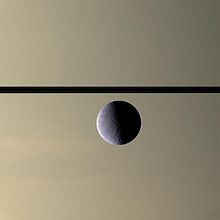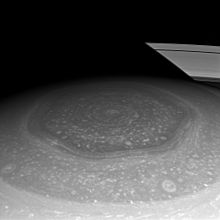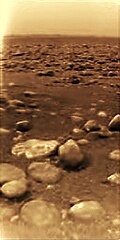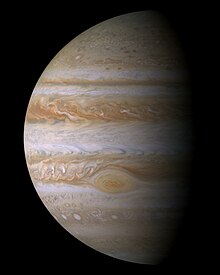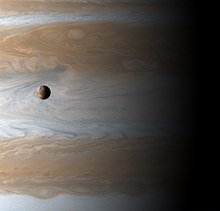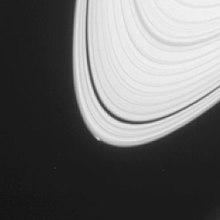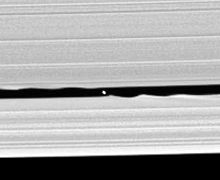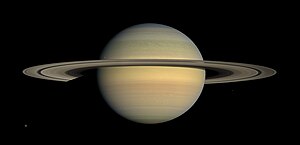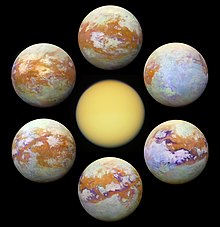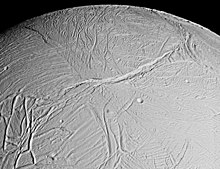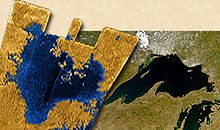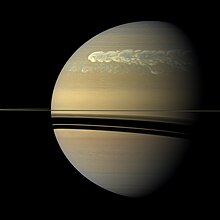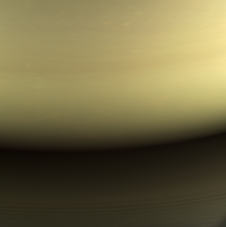
Artist's concept of Cassini's orbit insertion around Saturn
| |
| Mission type | Cassini: Saturn orbiter Huygens: Titan lander |
|---|---|
| Operator | Cassini: NASA / JPL Huygens: ESA / ASI |
| COSPAR ID | 1997-061A |
| SATCAT no. | 25008 |
| Website | |
| Mission duration |
|
| Spacecraft properties | |
| Manufacturer | Cassini: Jet Propulsion Laboratory Huygens: Thales Alenia Space |
| Launch mass | 5,712 kg (12,593 lb) |
| Dry mass | 2,523 kg (5,562 lb) |
| Power | ~885 watts (BOL) ~670 watts (2010) ~663 watts (EOM/2017) |
| Start of mission | |
| Launch date | October 15, 1997, 08:43:00 UTC |
| Rocket | Titan IV(401)B B-33 |
| Launch site | Cape Canaveral SLC-40 |
| End of mission | |
| Disposal | Controlled entry into Saturn |
| Last contact | September 15, 2017
|
| Orbital parameters | |
| Reference system | Kronocentric |
| Flyby of Venus (Gravity assist) | |
| Closest approach | April 26, 1998 |
| Distance | 283 km (176 mi) |
| Flyby of Venus (Gravity assist) | |
| Closest approach | June 24, 1999 |
| Distance | 6,052 km (3,761 mi) |
| Flyby of Earth-Moon system (Gravity assist) | |
| Closest approach | August 18, 1999, 03:28 UTC |
| Distance | 1,171 km (728 mi) |
| Flyby of 2685 Masursky (Incidental) | |
| Closest approach | January 23, 2000 |
| Distance | 1,600,000 km (990,000 mi) |
| Flyby of Jupiter (Gravity assist) | |
| Closest approach | December 30, 2000 |
| Distance | 9,852,924 km (6,122,323 mi) |
| Saturn orbiter | |
| Orbital insertion | July 1, 2004, 02:48 UTC |
| Titan lander | |
| Spacecraft component | Huygens |
| Landing date | January 14, 2005 |
The Cassini–Huygens mission (/kəˈsiːni
Launched aboard a Titan IVB/Centaur on October 15, 1997, Cassini was active in space for nearly 20 years, with 13 years spent orbiting Saturn, studying the planet and its system after entering orbit on July 1, 2004. The voyage to Saturn included flybys of Venus (April 1998 and July 1999), Earth (August 1999), the asteroid 2685 Masursky, and Jupiter (December 2000). Its mission ended on September 15, 2017, when Cassini's trajectory took it into Saturn's upper atmosphere and it burned up in order to prevent any risk of contaminating Saturn's moons, which might have offered habitable environments to stowaway terrestrial microbes on the spacecraft. The mission is widely perceived to have been successful beyond expectation. Cassini-Huygens has been described by NASA's Planetary Science Division Director as a "mission of firsts", that has revolutionized human understanding of the Saturn system, including its moons and rings, and our understanding of where life might be found in the Solar System.
Cassini's original mission was planned to last for four years, from June 2004 to May 2008. The mission was extended for another two years until September 2010, branded the Cassini Equinox Mission. The mission was extended a second and final time with the Cassini Solstice Mission, lasting another seven years until September 15, 2017, on which date Cassini was de-orbited to burn up in Saturn's upper atmosphere.
The Huygens module traveled with Cassini until its separation from the probe on December 25, 2004; it was landed by parachute on Titan on January 14, 2005. It returned data to Earth for around 90 minutes, using the orbiter as a relay. This was the first landing ever accomplished in the outer Solar System and the first landing on a moon other than our own.
At the end of its mission, the Cassini spacecraft executed the "Grand Finale" of its mission: a number of risky passes through the gaps between Saturn and Saturn's inner rings. The purpose of this phase was to maximize Cassini's scientific outcome before the spacecraft was disposed. The atmospheric entry of Cassini ended the mission, but analyses of the returned data will continue for many years.
Overview
Teams from 28 countries made up the joint team responsible for designing, building, flying and collecting data from the Cassini orbiter and Huygens probe.
The mission was managed by NASA's Jet Propulsion Laboratory in the United States, where the orbiter was assembled. Huygens was developed by the European Space Research and Technology Centre. The Centre's prime contractor, Aérospatiale of France (now Thales Alenia Space), assembled the probe with equipment and instruments supplied by many European countries (Huygens' batteries and two scientific instruments by the United States). The Italian Space Agency (ASI) provided the Cassini orbiter's high-gain radio antenna,
with the incorporation of a low-gain antenna (to ensure
telecommunications with the Earth for the entire duration of the
mission), a compact and lightweight radar, which also uses the high-gain antenna and serves as a synthetic-aperture radar, a radar altimeter, a radiometer, the radio science subsystem (RSS), the visible channel portion VIMS-V of VIMS spectrometer.
The VIMS infrared counterpart was provided by NASA, as well as Main Electronic Assembly, which includes electronic subassemblies provided by CNES of France.
On April 16, 2008, NASA announced a two-year extension of the
funding for ground operations of this mission, at which point it was
renamed the Cassini Equinox Mission. The round of funding was again extended in February 2010 with the Cassini Solstice Mission.
Naming
Huygens' explanation for the aspects of Saturn, Systema Saturnium (1659)
The mission consisted of two main elements: the ASI/NASA Cassini orbiter, named for the Italian astronomer Giovanni Domenico Cassini, discoverer of Saturn's ring divisions and four of its satellites; and the ESA-developed Huygens probe, named for the Dutch astronomer, mathematician and physicist Christiaan Huygens, discoverer of Titan.
The mission was commonly called Saturn Orbiter Titan Probe (SOTP) during gestation, both as a Mariner Mark II mission and generically.
Cassini-Huygens was a Flagship-class mission to the outer planets. The other planetary flagships include Galileo, Voyager, and Viking.
Objectives
Cassini had several objectives, including:
- Determining the three-dimensional structure and dynamic behavior of the rings of Saturn.
- Determining the composition of the satellite surfaces and the geological history of each object.
- Determining the nature and origin of the dark material on Iapetus's leading hemisphere.
- Measuring the three-dimensional structure and dynamic behavior of the magnetosphere.
- Studying the dynamic behavior of Saturn's atmosphere at cloud level.
- Studying the time variability of Titan's clouds and hazes.
- Characterizing Titan's surface on a regional scale.
Cassini–Huygens was launched on October 15, 1997, from Cape Canaveral Air Force Station's Space Launch Complex 40 using a U.S. Air Force Titan IVB/Centaur rocket. The complete launcher was made up of a two-stage Titan IV booster rocket, two strap-on solid rocket engines, the Centaur upper stage, and a payload enclosure, or fairing.
The total cost of this scientific exploration mission was about US$3.26 billion, including $1.4 billion for pre-launch development, $704 million
for mission operations, $54 million for tracking and $422 million for
the launch vehicle. The United States contributed $2.6 billion (80%),
the ESA $500 million (15%), and the ASI $160 million (5%).
However, these figures are from the press kit which was prepared in
October 2000. They do not include inflation over the course of a very
long mission, nor do they include the cost of the extended missions.
The primary mission for Cassini was completed on July 30, 2008. The mission was extended to June 2010 (Cassini Equinox Mission). This studied the Saturn system in detail during the planet's equinox, which happened in August 2009.
On February 3, 2010, NASA announced another extension for Cassini, lasting 61⁄2 years until 2017, ending at the time of summer solstice in Saturn's northern hemisphere (Cassini Solstice Mission). The extension enabled another 155 revolutions around the planet, 54 flybys of Titan and 11 flybys of Enceladus.
In 2017, an encounter with Titan changed its orbit in such a way that,
at closest approach to Saturn, it was only 3,000 km above the planet's
cloudtops, below the inner edge of the D ring.
This sequence of "proximal orbits" ended when its final encounter with
Titan sent the probe into Saturn's atmosphere to be destroyed.
History
Cassini-Huygens on the launch pad
Cassini–Huygens's origins date to 1982, when the European Science Foundation and the American National Academy of Sciences formed a working group
to investigate future cooperative missions. Two European scientists
suggested a paired Saturn Orbiter and Titan Probe as a possible joint
mission. In 1983, NASA's Solar System Exploration Committee recommended the same Orbiter and Probe pair as a core NASA project. NASA and the European Space Agency
(ESA) performed a joint study of the potential mission from 1984 to
1985. ESA continued with its own study in 1986, while the American
astronaut Sally Ride, in her influential 1987 report NASA Leadership and America's Future in Space, also examined and approved of the Cassini mission.
While Ride's report described the Saturn orbiter and probe as a
NASA solo mission, in 1988 the Associate Administrator for Space Science
and Applications of NASA, Len Fisk, returned to the idea of a joint
NASA and ESA mission. He wrote to his counterpart at ESA, Roger Bonnet,
strongly suggesting that ESA choose the Cassini mission from the three candidates at hand and promising that NASA would commit to the mission as soon as ESA did.
At the time, NASA was becoming more sensitive to the strain that
had developed between the American and European space programs as a
result of European perceptions that NASA had not treated it like an
equal during previous collaborations. NASA officials and advisers
involved in promoting and planning Cassini–Huygens attempted to
correct this trend by stressing their desire to evenly share any
scientific and technology benefits resulting from the mission. In part,
this newfound spirit of cooperation with Europe was driven by a sense of
competition with the Soviet Union,
which had begun to cooperate more closely with Europe as ESA drew
further away from NASA. Late in 1988, ESA chose Cassini–Huygens as its
next major mission and the following year the program received major
funding in the US.
The collaboration not only improved relations between the two space programs but also helped Cassini–Huygens survive congressional budget cuts in the United States. Cassini–Huygens came under fire politically in both 1992 and 1994, but NASA successfully persuaded the United States Congress
that it would be unwise to halt the project after ESA had already
poured funds into development because frustration on broken space
exploration promises might spill over into other areas of foreign
relations. The project proceeded politically smoothly after 1994,
although citizens' groups concerned about its potential environmental
impact attempted to derail it through protests and lawsuits until and
past its 1997 launch.
Spacecraft design
Cassini-Huygens assembly
The spacecraft was planned to be the second three-axis stabilized, RTG-powered Mariner Mark II, a class of spacecraft developed for missions beyond the orbit of Mars. Cassini was developed simultaneously with the Comet Rendezvous Asteroid Flyby (CRAF) spacecraft, but budget cuts and project rescopings forced NASA to terminate CRAF development to save Cassini. As a result, Cassini became more specialized. The Mariner Mark II series was cancelled.
The combined orbiter and probe is the third-largest unmanned interplanetary spacecraft ever successfully launched, behind the Phobos 1 and 2 Mars probes, as well as being among the most complex.
The orbiter had a mass of 2,150 kg (4,740 lb), the probe 350 kg
(770 lb). With the launch vehicle adapter and 3,132 kg (6,905 lb) of
propellants at launch, the spacecraft had a mass of 5,600 kg
(12,300 lb).
The Cassini spacecraft was 6.8 meters (22 ft) high and 4 meters (13 ft) wide. Spacecraft complexity was increased by its trajectory (flight path) to Saturn, and by the ambitious science at its destination. Cassini had 1,630 interconnected electronic components, 22,000 wire connections, and 14 kilometers (8.7 mi) of cabling. The core control computer CPU was a redundant MIL-STD-1750A system. The main propulsion system consisted of one prime and one backup R-4D bipropellant rocket engine. The thrust of each engine was 490 newtons and the total spacecraft delta-v was about 2,040 meters per second. Smaller monopropellant rockets provided attitude control.
Cassini was powered by 32.7 kg of plutonium-238—the heat from the material's radioactive decay was turned into electricity. Huygens was supported by Cassini during cruise, but used chemical batteries when independent.
The probe contained a DVD with more than 616,400 signatures from citizens in 81 countries, collected in a public campaign.
Until September 2017 the Cassini probe continued orbiting Saturn at a distance of between 8.2 and 10.2 astronomical units from the Earth. It took 68 to 84 minutes for radio signals to travel
from Earth to the spacecraft, and vice versa. Thus ground controllers
could not give "real-time" instructions for daily operations or for
unexpected events. Even if response were immediate, more than two hours
would have passed between the occurrence of a problem and the reception
of the engineers' response by the satellite.
Instruments
Titan's surface revealed by VIMS
Rhea in front of Saturn
Saturn's north polar hexagon
Saturn in natural-color (July 2018)
Animated 3D model of the spacecraft
Summary
Instruments:
- Optical Remote Sensing ("Located on the remote sensing pallet")
- Composite Infrared Spectrometer (CIRS)
- Imaging Science Subsystem (ISS)
- Ultraviolet Imaging Spectrograph (UVIS)
- Visible and Infrared Mapping Spectrometer (VIMS)
- Fields, Particles and Waves (mostly in situ)
- Cassini Plasma Spectrometer (CAPS)
- Cosmic Dust Analyzer (CDA)
- Ion and Neutral Mass Spectrometer (INMS)
- Magnetometer (MAG)
- Magnetospheric Imaging Instrument (MIMI)
- Radio and Plasma Wave Science (RPWS)
- Microwave Remote Sensing
- Radar
- Radio Science (RSS)
Description
Cassini's instrumentation consisted of: a synthetic aperture radar mapper, a charge-coupled device imaging system, a visible/infrared mapping spectrometer, a composite infrared spectrometer, a cosmic dust analyzer, a radio and plasma wave experiment, a plasma spectrometer, an ultraviolet imaging spectrograph, a magnetospheric imaging instrument, a magnetometer and an ion/neutral mass spectrometer. Telemetry from the communications antenna and other special transmitters (an S-band transmitter and a dual-frequency Ka-band system) was also used to make observations of the atmospheres of Titan and Saturn and to measure the gravity fields of the planet and its satellites.
- Cassini Plasma Spectrometer (CAPS)
- CAPS was an in situ instrument that measured the flux of charged particles at the location of the spacecraft, as a function of direction and energy. The ion composition was also measured using a time-of-flight mass spectrometer. CAPS measured particles produced by ionisation of molecules originating from Saturn's and Titan's ionosphere, as well as the plumes of Enceladus. CAPS also investigated plasma in these areas, along with the solar wind and its interaction with Saturn's magnetosphere. CAPS was turned off in June 2011, as a precaution due to a "soft" electrical short circuit that occurred in the instrument. It was powered on again in March 2012, but after 78 days another short circuit forced the instrument to be shut down permanently.
- Cosmic Dust Analyzer (CDA)
- The CDA was an in situ instrument that measured the size, speed, and direction of tiny dust grains near Saturn. It could also measure the grains' chemical elements. Some of these particles orbited Saturn, while others came from other star systems. The CDA on the orbiter was designed to learn more about these particles, the materials in other celestial bodies and potentially about the origins of the universe.
- Composite Infrared Spectrometer (CIRS)
- The CIRS was a remote sensing instrument that measured the infrared radiation coming from objects to learn about their temperatures, thermal properties, and compositions. Throughout the Cassini–Huygens mission, the CIRS measured infrared emissions from atmospheres, rings and surfaces in the vast Saturn system. It mapped the atmosphere of Saturn in three dimensions to determine temperature and pressure profiles with altitude, gas composition, and the distribution of aerosols and clouds. It also measured thermal characteristics and the composition of satellite surfaces and rings.
- Ion and Neutral Mass Spectrometer (INMS)
- The INMS was an in situ instrument that measured the composition of charged particles (protons and heavier ions) and neutral particles (atoms and molecules) near Titan and Saturn to learn more about their atmospheres. The instrument used a quadrupole mass spectrometer. INMS was also intended to measure the positive ion and neutral environments of Saturn's icy satellites and rings.
- Imaging Science Subsystem (ISS)
- The ISS was a remote sensing instrument that captured most images in visible light, and also some infrared images and ultraviolet images. The ISS took hundreds of thousands of images of Saturn, its rings, and its moons. The ISS had both a wide-angle camera (WAC) and a narrow-angle camera (NAC). Each of these cameras used a sensitive charge-coupled device (CCD) as its electromagnetic wave detector. Each CCD had a 1,024 square array of pixels, 12 μm on a side. Both cameras allowed for many data collection modes, including on-chip data compression, and were fitted with spectral filters that rotated on a wheel to view different bands within the electromagnetic spectrum ranging from 0.2 to 1.1 μm.
- Dual Technique Magnetometer (MAG)
- The MAG was an in situ instrument that measured the strength and direction of the magnetic field around Saturn. The magnetic fields are generated partly by the molten core at Saturn's center. Measuring the magnetic field is one of the ways to probe the core. MAG aimed to develop a three-dimensional model of Saturn's magnetosphere, and determine the magnetic state of Titan and its atmosphere, and the icy satellites and their role in the magnetosphere of Saturn.
- Magnetospheric Imaging Instrument (MIMI)
- The MIMI was both an in situ and remote sensing instrument that produces images and other data about the particles trapped in Saturn's huge magnetic field, or magnetosphere. The in situ component measured energetic ions and electrons while the remote sensing component (the Ion And Neutral Camera, INCA) was an energetic neutral atom imager. This information was used to study the overall configuration and dynamics of the magnetosphere and its interactions with the solar wind, Saturn's atmosphere, Titan, rings, and icy satellites.
- Radar
- The on-board radar was an active and passive sensing instrument that produced maps of Titan's surface. Radar waves were powerful enough to penetrate the thick veil of haze surrounding Titan. By measuring the send and return time of the signals it is possible to determine the height of large surface features, such as mountains and canyons. The passive radar listened for radio waves that Saturn or its moons may emit.
- Radio and Plasma Wave Science instrument (RPWS)
- The RPWS was an in situ instrument and remote sensing instrument that receives and measures radio signals coming from Saturn, including the radio waves given off by the interaction of the solar wind with Saturn and Titan. RPWS measured the electric and magnetic wave fields in the interplanetary medium and planetary magnetospheres. It also determined the electron density and temperature near Titan and in some regions of Saturn's magnetosphere using either plasma waves at characteristic frequencies (e.g. the upper hybrid line) or a Langmuir probe. RPWS studied the configuration of Saturn's magnetic field and its relationship to Saturn Kilometric Radiation (SKR), as well as monitoring and mapping Saturn's ionosphere, plasma, and lightning from Saturn's (and possibly Titan's) atmosphere.
- Radio Science Subsystem (RSS)
- The RSS was a remote-sensing instrument that used radio antennas on Earth to observe the way radio signals from the spacecraft changed as they were sent through objects, such as Titan's atmosphere or Saturn's rings, or even behind the Sun. The RSS also studied the compositions, pressures and temperatures of atmospheres and ionospheres, radial structure and particle size distribution within rings, body and system masses and the gravitational field. The instrument used the spacecraft X-band communication link as well as S-band downlink and Ka-band uplink and downlink.
VIMS spectra taken while looking through Titan's atmosphere towards the Sun helped understand the atmospheres of exoplanets (artist's concept; May 27, 2014).
- Ultraviolet Imaging Spectrograph (UVIS)
- The UVIS was a remote-sensing instrument that captured images of the ultraviolet light reflected off an object, such as the clouds of Saturn and/or its rings, to learn more about their structure and composition. Designed to measure ultraviolet light over wavelengths from 55.8 to 190 nm, this instrument was also a tool to help determine the composition, distribution, aerosol particle content and temperatures of their atmospheres. Unlike other types of spectrometer, this sensitive instrument could take both spectral and spatial readings. It was particularly adept at determining the composition of gases. Spatial observations took a wide-by-narrow view, only one pixel tall and 64 pixels across. The spectral dimension was 1,024 pixels per spatial pixel. It could also take many images that create movies of the ways in which this material is moved around by other forces.
- Visible and Infrared Mapping Spectrometer (VIMS)
- The VIMS was a remote sensing instrument that captured images using visible and infrared light to learn more about the composition of moon surfaces, the rings, and the atmospheres of Saturn and Titan. It consisted of two cameras - one used to measure visible light, the other infrared. VIMS measured reflected and emitted radiation from atmospheres, rings and surfaces over wavelengths from 350 to 5100 nm, to help determine their compositions, temperatures and structures. It also observed the sunlight and starlight that passes through the rings to learn more about their structure. Scientists used VIMS for long-term studies of cloud movement and morphology in the Saturn system, to determine Saturn's weather patterns.
Plutonium power source
A Cassini RTG before installation
Because of Saturn's distance from the Sun, solar arrays were not feasible as power sources for this space probe. To generate enough power, such arrays would have been too large and too heavy. Instead, the Cassini orbiter was powered by three radioisotope thermoelectric generators (RTGs), which use heat from the natural decay of about 33 kg (73 lb) of plutonium-238 (in the form of plutonium dioxide) to generate direct current electricity via thermoelectrics.
The RTGs on the Cassini mission have the same design as those used on the New Horizons, Galileo, and Ulysses space probes, and they were designed to have very long operational lifetimes.
At the end of the nominal 11-year Cassini mission, they were still able to produce 600 to 700 watts of electrical power. (One of the spare RTGs for the Cassini mission was used to power the New Horizons mission to Pluto and the Kuiper belt, which was designed and launched later.)
A glowing-hot plutonium pellet that is the power source of the probe's radioisotope thermoelectric generator
To gain momentum while already in flight, the trajectory of the Cassini mission included several gravitational slingshot maneuvers: two fly-by passes of Venus, one more of the Earth, and then one of the planet Jupiter.
The terrestrial flyby was the final instance when the probe posed any
conceivable danger to human beings. The maneuver was successful, with Cassini passing by 1,171 km (728 mi) above the Earth on August 18, 1999.
Had there been any malfunction causing the probe to collide with the
Earth, NASA's complete environmental impact study estimated that, in the
worst case (with an acute angle of entry in which Cassini would gradually burn up), a significant fraction of the 33 kg
of plutonium-238 inside the RTGs would have been dispersed into the
Earth's atmosphere so that up to five billion people (i.e. almost the
entire terrestrial population) could have been exposed, causing up to an
estimated 5,000 additional cancer deaths over the subsequent decades
(0.0005 per cent, i.e. a fraction 0.000005, of a billion cancer deaths
expected anyway from other causes; the product is incorrectly calculated
elsewhere as 500,000 deaths). However, the chance of this happening were estimated to be less than one in one million.
Telemetry
The Cassini
spacecraft was capable of transmitting in several different telemetry
formats. The telemetry subsystem is perhaps the most important
subsystem, because without it there could be no data return.
The telemetry was developed from ground up, due to the spacecraft using a more modern set of computers than previous missions. Therefore, Cassini was the first spacecraft to adopt mini-packets
to reduce the complexity of the Telemetry Dictionary, and the software
development process led to the creation of a Telemetry Manager for the
mission.
There were around 1088 channels (in 67 mini-packets) assembled in the Cassini
Telemetry Dictionary. Out of these 67 lower complexity mini-packets, 6
mini-packets contained the subsystem covariance and Kalman gain elements
(161 measurements), not used during normal mission operations. This
left 947 measurements in 61 mini-packets.
A total of seven telemetry maps corresponding to 7 AACS telemetry
modes were constructed. These modes are: (1) Record; (2) Nominal
Cruise; (3) Medium Slow Cruise; (4) Slow Cruise; (5) Orbital Ops; (6)
Av; (7) ATE (Attitude Estimator) Calibration. These 7 maps cover all
spacecraft telemetry modes.
Huygens probe
The Huygens probe, supplied by the European Space Agency (ESA) and named after the 17th century Dutch astronomer who first discovered Titan, Christiaan Huygens,
scrutinized the clouds, atmosphere, and surface of Saturn's moon Titan
in its descent on January 15, 2005. It was designed to enter and brake
in Titan's atmosphere and parachute a fully instrumented robotic
laboratory down to the surface.
The probe system consisted of the probe itself which descended to
Titan, and the probe support equipment (PSE) which remained attached to
the orbiting spacecraft. The PSE includes electronics that track the
probe, recover the data gathered during its descent, and process and
deliver the data to the orbiter that transmits it to Earth. The core
control computer CPU was a redundant MIL-STD-1750A control system.
The data were transmitted by a radio link between Huygens and Cassini
provided by Probe Data Relay Subsystem (PDRS). As the probe's mission
could not be telecommanded from Earth because of the great distance, it
was automatically managed by the Command Data Management Subsystem
(CDMS). The PDRS and CDMS were provided by the Italian Space Agency (ASI).
After Cassini's
launch, it was discovered that data sent back from the probe to
European Space Agency's mission control center was largely unreadable.
It was determined that Cassini's receiver was unable to accurately process the changes in frequency and wavelength of the signal it would be receiving from Huygens during its descent to Titan. The problem was rectified by changing the distance and angle of Cassini's trajectory to Huygens during the landing.
Selected events and discoveries
Venus and Earth fly-bys and the cruise to Jupiter
Picture of the Moon during flyby
The Cassini space probe performed two gravitational-assist flybys of Venus
on April 26, 1998, and June 24, 1999. These flybys provided the space
probe with enough momentum to travel all the way out to the asteroid belt. At that point, the Sun's gravity pulled the space probe back into the inner Solar System.
On August 18, 1999, at 03:28 UTC, the craft made a
gravitational-assist flyby of the Earth. One hour and 20 minutes before
closest approach, Cassini made its closest approach to the Earth's Moon at 377,000 kilometers, and it took a series of calibration photos.
On January 23, 2000, Cassini performed a flyby of the asteroid 2685 Masursky at around 10:00 UTC. It took photos
in the period five to seven hours before the flyby at a distance of
1.6 million kilometers, and a diameter of 15 to 20 km was estimated for
the asteroid.
Jupiter flyby
A Jupiter flyby picture
Cassini made its closest approach to Jupiter on December 30,
2000, and made many scientific measurements. About 26,000 images of
Jupiter, its faint rings, and its moons
were taken during the six month flyby. It produced the most detailed
global color portrait of the planet yet (see image at right), in which
the smallest visible features are approximately 60 km (37 mi) across.
Cassini photographed Io transiting Jupiter on January 1, 2001.
A major finding of the flyby, announced on March 6, 2003, was of
Jupiter's atmospheric circulation. Dark "belts" alternate with light
"zones" in the atmosphere, and scientists had long considered the zones,
with their pale clouds, to be areas of upwelling air, partly because
many clouds on Earth form where air is rising. But analysis of Cassini
imagery showed that individual storm cells of upwelling bright-white
clouds, too small to see from Earth, pop up almost without exception in
the dark belts. According to Anthony Del Genio of NASA's Goddard Institute for Space Studies, "the belts must be the areas of net-rising atmospheric motion on Jupiter, [so] the net motion in the zones has to be sinking."
Other atmospheric observations included a swirling dark oval of high atmospheric-haze, about the size of the Great Red Spot,
near Jupiter's north pole. Infrared imagery revealed aspects of
circulation near the poles, with bands of globe-encircling winds, with
adjacent bands moving in opposite directions.
The same announcement also discussed the nature of Jupiter's rings.
Light scattering by particles in the rings showed the particles were
irregularly shaped (rather than spherical) and likely originate as
ejecta from micrometeorite impacts on Jupiter's moons, probably Metis and Adrastea.
Tests of general relativity
On October 10, 2003, the mission's science team announced the results of tests of Albert Einstein's general theory of relativity, performed by using radio waves transmitted from the Cassini space probe. The radio scientists measured a frequency
shift in the radio waves to and from the spacecraft, as those passed
close to the Sun. According to the general theory of relativity, a
massive object like the Sun causes space-time to curve, causing a beam
of radiowaves (or light, or any form of electromagnetic radiation) that passes by the Sun to travel farther (known as the Shapiro time delay).
Although some measurable deviations from the values calculated using the general theory of relativity
are predicted by some unusual cosmological models, no such deviations
were found by this experiment. Previous tests using radiowaves
transmitted by the Viking and Voyager space probes were in
agreement with the calculated values from general relativity to within
an accuracy of one part in one thousand. The more refined measurements
from the Cassini space probe experiment improved this accuracy to about one part in 51,000. The data firmly support Einstein's general theory of relativity.
New moons of Saturn
The possible formation of a new moon was captured on April 15, 2013.
In total, the Cassini mission discovered seven new moons orbiting Saturn. Using images taken by Cassini, researchers discovered Methone, Pallene and Polydeuces in 2004, although later analysis revealed that Voyager 2 had photographed Pallene in its 1981 flyby of the ringed planet.
Discovery photograph of moon Daphnis
On May 1, 2005, a new moon was discovered by Cassini in the Keeler gap. It was given the designation S/2005 S 1 before being named Daphnis. A fifth new moon was discovered by Cassini on May 30, 2007, and was provisionally labeled S/2007 S 4. It is now known as Anthe. A press release on February 3, 2009 showed a sixth new moon found by Cassini. The moon is approximately 1/3 of a mile (500 m) in diameter within the G-ring of the ring system of Saturn, and is now named Aegaeon (formerly S/2008 S 1). A press release on November 2, 2009 mentions the seventh new moon found by Cassini on July 26, 2009. It is presently labeled S/2009 S 1 and is approximately 300 m (1000 ft) in diameter in the B-ring system.
On April 14, 2014, NASA scientists reported the possible beginning of a new moon in Saturn's A Ring.
Phoebe flyby
Cassini arrival (left) and departure mosaics of Phoebe (2004)
On June 11, 2004, Cassini flew by the moon Phoebe. This was the first opportunity for close-up studies of this moon (Voyager 2 performed a distant flyby in 1981 but returned no detailed images). It also was Cassini's only possible flyby for Phoebe due to the mechanics of the available orbits around Saturn.
The first close-up images were received on June 12, 2004, and
mission scientists immediately realized that the surface of Phoebe looks
different from asteroids visited by spacecraft. Parts of the heavily
cratered surface look very bright in those pictures, and it is currently
believed that a large amount of water ice exists under its immediate
surface.
Saturn rotation
In an announcement on June 28, 2004, Cassini program scientists described the measurement of the rotational period of Saturn.
Because there are no fixed features on the surface that can be used to
obtain this period, the repetition of radio emissions was used. This new
data agreed with the latest values measured from Earth, and constituted
a puzzle to the scientists. It turns out that the radio rotational
period had changed since it was first measured in 1980 by Voyager 1,
and it was now 6 minutes longer. This, however, does not indicate a
change in the overall spin of the planet. It is thought to be due to
variations in the upper atmosphere and ionosphere at the latitudes which
are magnetically connected to the radio source region.
Orbiting Saturn
Saturn reached equinox in 2008, shortly after the end of the prime mission.
On July 1, 2004, the spacecraft flew through the gap between the F and G rings and achieved orbit, after a seven-year voyage. It was the first spacecraft to ever orbit Saturn.
The Saturn Orbital Insertion (SOI) maneuver performed by Cassini
was complex, requiring the craft to orient its High-Gain Antenna away
from Earth and along its flight path, to shield its instruments from
particles in Saturn's rings. Once the craft crossed the ring plane, it
had to rotate again to point its engine along its flight path, and then
the engine fired to decelerate the craft by 622 meters/s to allow Saturn
to capture it. Cassini was captured by Saturn's gravity at around 8:54 pm Pacific Daylight Time on June 30, 2004. During the maneuver Cassini passed within 20,000 km (12,000 mi) of Saturn's cloud tops.
When Cassini was in Saturnian orbit, departure from the Saturn system was evaluated in 2008 during end of mission planning.
Titan flybys
Titan – infrared views (2004 – 2017)
Cassini had its first flyby of Saturn's largest moon, Titan,
on July 2, 2004, a day after orbit insertion, when it approached to
within 339,000 km (211,000 mi) of Titan. Images taken through special
filters (able to see through the moon's global haze) showed south polar
clouds thought to be composed of methane
and surface features with widely differing brightness. On October 27,
2004, the spacecraft executed the first of the 45 planned close flybys
of Titan when it passed a mere 1,200 kilometers above the moon. Almost
four gigabits
of data were collected and transmitted to Earth, including the first
radar images of the moon's haze-enshrouded surface. It revealed the
surface of Titan (at least the area covered by radar) to be relatively
level, with topography reaching no more than about 50 meters in
altitude. The flyby provided a remarkable increase in imaging resolution
over previous coverage. Images with up to 100 times better resolution
were taken and are typical of resolutions planned for subsequent Titan
flybys. Cassini collected pictures of Titan and the lakes of methane
were similar to the lakes of Earth.
Huygens lands on Titan
Cassini released the Huygens probe on December 25,
2004, by means of a spring and spiral rails intended to rotate the probe
for greater stability. It entered the atmosphere of Titan on January
14, 2005, and after a two-and-a-half-hour descent landed on solid
ground. Although Cassini successfully relayed 350 of the pictures that it received from Huygens of its descent and landing site, a software error failed to turn on one of the Cassini receivers and caused the loss of another 350 pictures. While landing, for caution, NASA loaded Huygens with 3 parachutes.
Enceladus flybys
View of Enceladus's Europa-like surface with the Labtayt Sulci fractures at center and the Ebony (left) and Cufa dorsa at lower left; imaged by Cassini on February 17, 2005
During the first two close flybys of the moon Enceladus in 2005, Cassini
discovered a deflection in the local magnetic field that is
characteristic for the existence of a thin but significant atmosphere.
Other measurements obtained at that time point to ionized water vapor as
its main constituent. Cassini also observed water ice geysers
erupting from the south pole of Enceladus, which gives more credibility
to the idea that Enceladus is supplying the particles of Saturn's E
ring. Mission scientists began to suspect that there may be pockets of
liquid water near the surface of the moon that fuel the eruptions.
On March 12, 2008, Cassini made a close fly-by of Enceladus, passing within 50 km of the moon's surface.
The spacecraft passed through the plumes extending from its southern
geysers, detecting water, carbon dioxide and various hydrocarbons with
its mass spectrometer, while also mapping surface features that are at
much higher temperature than their surroundings with the infrared
spectrometer. Cassini was unable to collect data with its cosmic dust analyzer due to an unknown software malfunction.
On November 21, 2009, Cassini made its eighth flyby of Enceladus,
this time with a different geometry, approaching within 1,600
kilometers (990 mi) of the surface. The Composite Infrared Spectrograph
(CIRS) instrument produced a map of thermal emissions from the Baghdad Sulcus 'tiger stripe'.
The data returned helped create a detailed and high resolution mosaic
image of the southern part of the moon's Saturn-facing hemisphere.
On April 3, 2014, nearly ten years after Cassini entered
Saturn's orbit, NASA reported evidence of a large salty internal ocean
of liquid water in Enceladus. The presence of an internal salty ocean in
contact with the moon's rocky core, places Enceladus "among the most
likely places in the Solar System to host alien microbial life". On June 30, 2014, NASA celebrated ten years of Cassini exploring Saturn and its moons, highlighting the discovery of water activity on Enceladus among other findings.
In September 2015, NASA announced that gravitational and imaging data from Cassini were used to analyze the librations
of Enceladus' orbit and determined that the moon's surface is not
rigidly joined to its core, concluding that the underground ocean must
therefore be global in extent.
On October 28, 2015, Cassini performed a close flyby of Enceladus, coming within 49 km (30 mi) of the surface, and passing through the icy plume above the south pole.
Radio occultations of Saturn's rings
In May 2005, Cassini began a series of radio occultation experiments, to measure the size-distribution of particles in Saturn's rings,
and measure the atmosphere of Saturn itself. For over four months, the
craft completed orbits designed for this purpose. During these
experiments, it flew behind the ring plane of Saturn, as seen from
Earth, and transmitted radio waves through the particles. The radio
signals received on Earth were analyzed, for frequency, phase, and power
shift of the signal to determine the structure of the rings.
Spokes in rings verified
In images captured September 5, 2005, Cassini detected spokes in Saturn's rings, previously seen only by the visual observer Stephen James O'Meara in 1977 and then confirmed by the Voyager space probes in the early 1980s.
Lakes of Titan
Ligeia Mare, on the left, is compared at scale to Lake Superior.
Titan - Evolving feature in Ligeia Mare (August 21, 2014).
Radar images obtained on July 21, 2006 appear to show lakes of liquid hydrocarbon (such as methane and ethane)
in Titan's northern latitudes. This is the first discovery of currently
existing lakes anywhere besides on Earth. The lakes range in size from
one to one-hundred kilometers across.
On March 13, 2007, the Jet Propulsion Laboratory
announced that it had found strong evidence of seas of methane and
ethane in the northern hemisphere of Titan. At least one of these is
larger than any of the Great Lakes in North America.
Saturn hurricane
In November 2006, scientists discovered a storm at the south pole of Saturn with a distinct eyewall. This is characteristic of a hurricane on Earth and had never been seen on another planet before. Unlike a terrestrial
hurricane, the storm appears to be stationary at the pole. The storm is
8,000 kilometers (5,000 mi) across, and 70 kilometers (43 mi) high,
with winds blowing at 560 kilometers per hour (350 mph).
Iapetus flyby
Taken
on September 10, 2007 at a distance of 62,331 km (38,731 mi) Iapetus's
equatorial ridge and surface are revealed. (CL1 and CL2 filters)
Closeup of Iapetus surface, 2007
On September 10, 2007, Cassini completed its flyby of the strange, two-toned, walnut-shaped moon, Iapetus. Images were taken from 1,000 miles (1,600 km) above the surface. As it was sending the images back to Earth, it was hit by a cosmic ray that forced it to temporarily enter safe mode. All of the data from the flyby were recovered.
Mission extension
On April 15, 2008, Cassini received funding for a 27-month extended mission. It consisted of 60 more orbits of Saturn, with 21 more close Titan flybys, seven of Enceladus, six of Mimas, eight of Tethys, and one targeted flyby each of Dione, Rhea, and Helene. The extended mission began on July 1, 2008, and was renamed the Cassini Equinox Mission as the mission coincided with Saturn's equinox.
Second mission extension
A
proposal was submitted to NASA for a second mission extension
(September 2010 – May 2017), provisionally named the extended-extended
mission or XXM. This ($60M pa) was approved in February 2010 and renamed the Cassini Solstice Mission. It included Cassini orbiting Saturn 155 more times, conducting 54 additional flybys of Titan and 11 more of Enceladus.
Great Storm of 2010 and aftermath
Northern hemisphere storm in 2011
On October 25, 2012, Cassini witnessed the aftermath of the massive Great White Spot storm that recurs roughly every 30 years on Saturn.
Data from the composite infrared spectrometer (CIRS) instrument
indicated a powerful discharge from the storm that caused a temperature
spike in the stratosphere of Saturn 83 K (83 °C; 149 °F) above normal.
Simultaneously, a huge increase in ethylene
gas was detected by NASA researchers at Goddard Research Center in
Greenbelt, Maryland. Ethylene is a colorless gas that is highly
uncommon on Saturn and is produced both naturally and through man-made
sources on Earth. The storm that produced this discharge was first
observed by the spacecraft on December 5, 2010 in Saturn's northern
hemisphere. The storm is the first of its kind to be observed by a
spacecraft in orbit around Saturn as well as the first to be observed at
thermal infrared wavelengths, allowing scientists to observe the
temperature of Saturn's atmosphere and track phenomena that are
invisible to the naked eye. The spike of ethylene gas that was produced
by the storm reached levels that were 100 times more than those thought
possible for Saturn. Scientists have also determined that the storm
witnessed was the largest, hottest stratospheric vortex ever detected in
the Solar System, initially being larger than Jupiter's Great Red Spot.
Venus transit
On December 21, 2012, Cassini observed a transit of Venus across the Sun. The VIMS instrument analyzed sunlight passing through the Venusian atmosphere. VIMS previously observed the transit of exoplanet HD 189733 b.
The Day the Earth Smiled
On July 19, 2013, the probe was pointed towards Earth to capture an image of the Earth and the Moon,
as part of a natural light, multi-image portrait of the entire Saturn
system. The event was unique as it was the first time NASA informed the
public that a long-distance photo was being taken in advance. The imaging team said they wanted people to smile and wave to the skies, with Cassini scientist Carolyn Porco describing the moment as a chance to "celebrate life on the Pale Blue Dot".
Rhea flyby
On February 10, 2015, the Cassini spacecraft visited Rhea more closely, coming within 47,000 km (29,000 mi). The spacecraft observed the moon with its cameras producing some of the highest resolution color images yet of Rhea.
Hyperion flyby
Cassini performed its latest flyby of Saturn's moon Hyperion on May 31, 2015, at a distance of about 34,000 km (21,000 mi).
Dione flyby
Cassini performed its last flyby of Saturn's moon Dione on August 17, 2015, at a distance of about 475 km (295 mi). A previous flyby was performed on June 16.
Hexagon changes color
Between 2012 and 2016, the persistent hexagonal cloud pattern at Saturn's north pole changed from a mostly blue color to more of a golden color. One theory for this is a seasonal change: extended exposure to sunlight may be creating haze as the pole swivels toward the sun. It was previously noted that there was less blue color overall on Saturn between 2004 and 2008.
2012 and 2016:
hexagon color changes
hexagon color changes
2013 and 2017:
hexagon color changes
hexagon color changes
Grand Finale and destruction
Cassini's end involved a series of close Saturn passes, approaching within the rings, then an entry into Saturn's atmosphere on September 15, 2017, to destroy the spacecraft. This method was chosen because it is imperative to ensure protection and prevent biological contamination to any of the moons of Saturn thought to offer potential habitability.
In 2008 a number of options were evaluated to achieve this goal,
each with varying funding, scientific, and technical challenges.
A short period Saturn impact for an end of mission was rated
"excellent" with the reasons "D-ring option satisfies unachieved AO
goals; cheap and easily achievable" while collision with an icy moon was
rated "good" for being "cheap and achievable anywhere/time".
On November 29, 2016, the spacecraft performed a Titan flyby that
took it to the gateway of F-ring orbits: This was the start of the
Grand Finale phase culminating in its impact with the planet. A final Titan flyby on April 22, 2017, changed the orbit again to fly
through the gap between Saturn and its inner ring days later on April
26. Cassini passed about 3,100 km (1,900 mi) above Saturn's cloud
layer and 320 km (200 mi) from the visible edge of the inner ring; it
successfully took images of Saturn's atmosphere and began returning data
the next day.
After a further 22 orbits through the gap, the mission was ended with a
dive into Saturn's atmosphere on September 15; signal was lost at
7:55:46 AM EDT
on September 15, 2017, just 30 seconds later than predicted. It is
estimated that the spacecraft burned up about 45 seconds after the last
transmission.
In September 2018, NASA won an Emmy Award for Outstanding Original Interactive Program for its presentation of the Cassini mission's Grand Finale at Saturn.
A close-up image of Saturn's atmosphere from about 3,100 km (1,900 mi) above the cloud layer, taken by Cassini on its first dive on April 26, 2017, at the start of the Grand Finale
Last image (color) taken by Cassini as it descended toward Saturn. The image was taken 634,000 km (394,000 mi) above Saturn on September 14, 2017, at 19:59 UTC.
Missions
The spacecraft operation was organized around a series of missions. Each is structured according to a certain amount of funding, goals, etc. At least 260 scientists from 17 countries have worked on the Cassini–Huygens mission; in addition thousands of people overall worked to design, manufacture, and launch the mission.
- Prime Mission, July 2004 through June 2008.
- Cassini Equinox Mission was a two-year mission extension which ran from July 2008 through September 2010.
- Cassini Solstice Mission ran from October 2010 through April 2017. (Also known as the XXM mission.)
- Grand Finale (spacecraft directed into Saturn), April 2017 to September 15, 2017.
- Farewell to Saturn and moons (Enceladus, Epimetheus, Janus, Mimas, Pandora and Prometheus)
(November 21, 2017)




